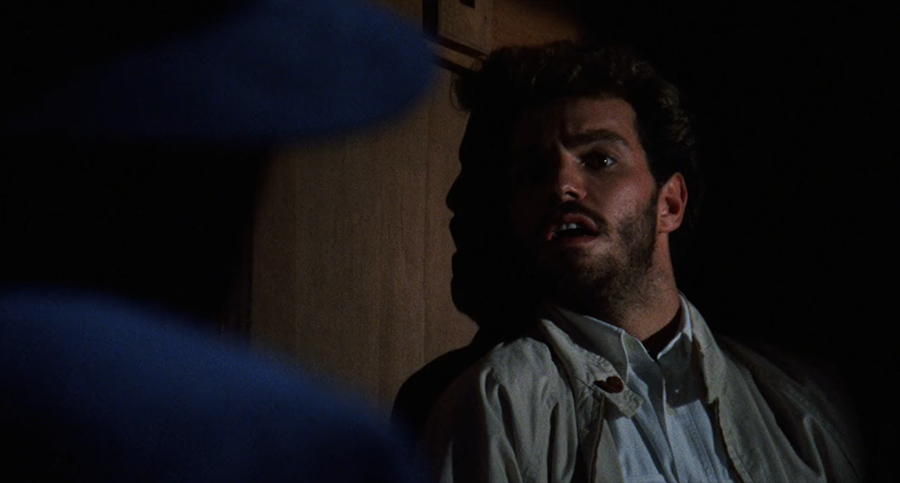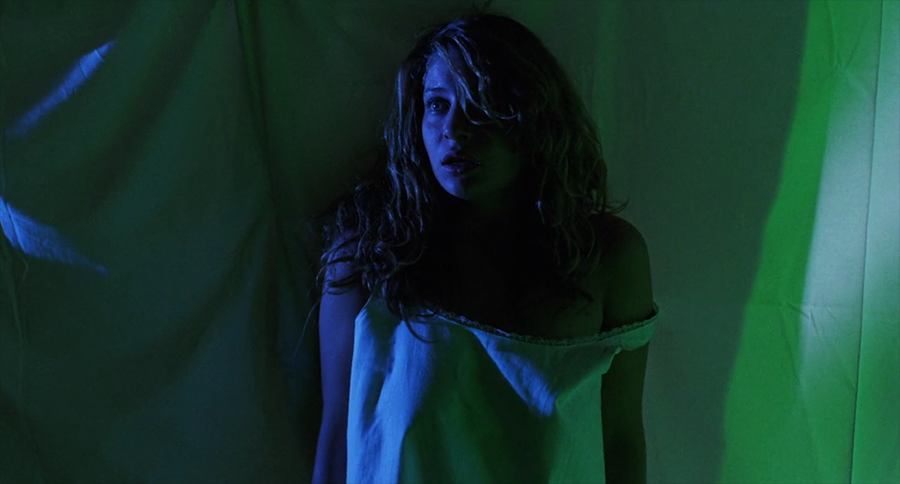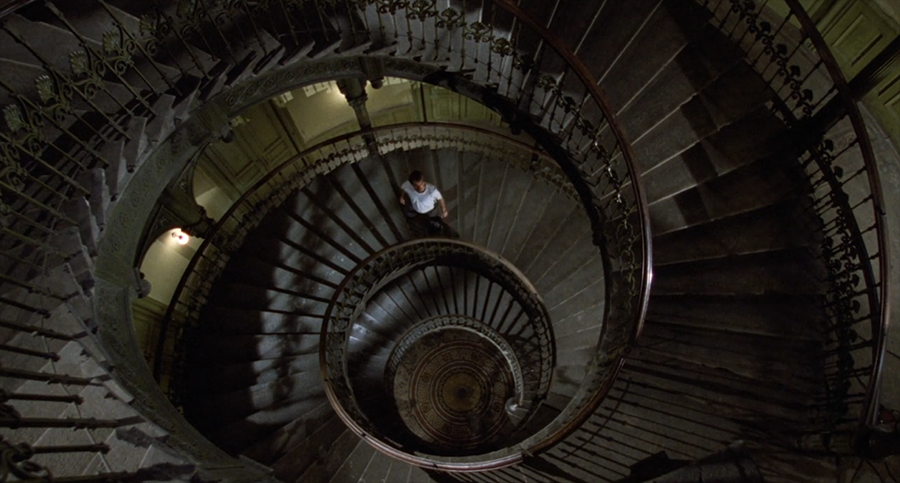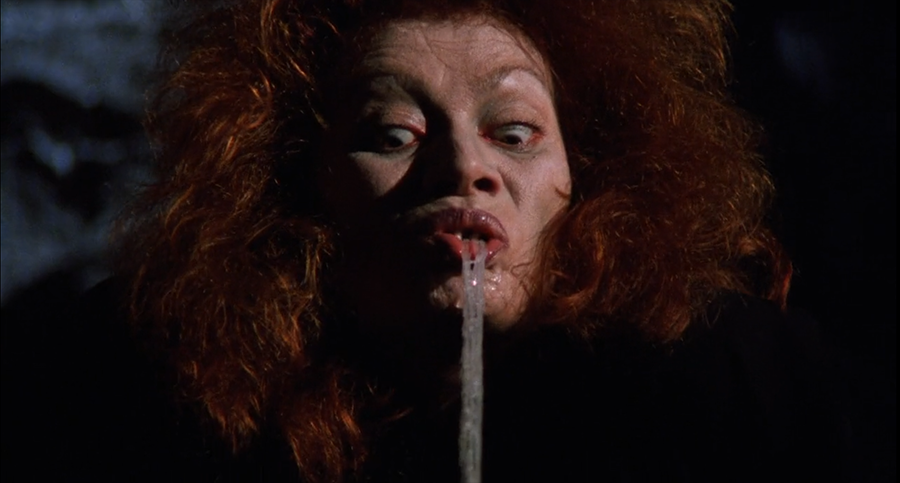THE SPIDER LABYRINTH
Directed by Gianfranco Giagni. 1988. Italy.

Located on the corner of Innsmouth Street and Suspiria Road is THE SPIDER LABYRINTH, a quaint little shocker serving up Italian cinematic cuisine with a delicious Yog-Sothian twist. A discerning palate might detect subtle notes of Wicker Man and perhaps a hint of European Gothic. A wonderful mix of seasonings and spices, cooked at a slow simmer for 90 minutes, sure to satisfy any craving a fan of Italian weirdness might have. In other words, I’m very hungry.
In all seriousness, Gianfranco Giagni’s film is, for the most part, an incredible success, a weird combination of Lovecraft and Argento, set in hotels, sewer tunnels, and rundown buildings that look torn out of a Mario Bava movie. It is both a pastiche and an homage, created by people who clearly love the sources of their inspiration, warts and all. While it’s not free from discordantly bonkers bullshit, much of which fits this movie’s otherwise serious tone like a corncob fits an ear canal, there is plenty to love on display here. You could say it’s a tasty treat.
The movie starts with a young boy, Alan, being locked inside a large cupboard. Alan suffers from lifelong trauma as a result of this incident. Not because his friend decided to be a massive dick and lock him in there, but because Alan comes face to face with a large (and stop motion animated) spider. Many years later, Alan is a professor of Oriental Languages working in Dallas, and a coordinator of the Intextus Project, an international group researching an ancient religion. One of the researchers in Budapest, Professor Roth, has gone radio silent. Alan’s superiors buy him a plane ticket and send him off to Hungry. He is to find out why Roth has stopped sending them his results.

Upon arriving, Alan makes the acquaintance of Genevieve, Roth’s attractive assistant, and Celia, his wife. Celia warns Alan that Roth might sound as nutty as a fruitcake, and guess what? He absolutely does. A disheveled Roth locks the two of them in the room and hands him a small notebook before warning Alan that it’s too dangerous to talk. He should come back later when it’s safer. Just then, a small black ball crashes through the window. Roth beats a quick retreat, leaving Alan to walk back to his hotel alone.
At his incredibly creepy, candy-colored hotel, Alan meets Mrs. Kuhn, the proprietor, and Maria, the maid. Everyone else stares at him while they eat their dinner. Alan spies on hot tamale Genevieve as she undresses in her hotel room across the street. Having promised Roth he would return to talk more, Alan heads out in a rainstorm, only to be stopped by a mysterious man who warns him that he will be trapped forever if he doesn’t leave the hotel tonight. Because this is a horror movie, Alan ignores him.
Arriving at Roth’s home, Alan finds the place swarming with police. He is led inside by Blasco, a police inspector, and taken to Roth’s study. Hanging from a noose covered in spiderwebs is Professor Roth, quite dead. Alan recalls his earlier meeting, only to be told that Roth never had a wife. But what about the ball thrown through the window? The supposedly shattered window is perfectly intact. Blasco, triggered by the inconsistencies in Alan’s story, seizes his passport. He is now a suspect. Back at the hotel, Alan is once again warned, this time by Maria. Alan, passportless and stupid, decides once again to ignore it.

After hearing the screams of a woman late at night, Alan investigates, finding Mrs. Kuhn sitting alone in an upstairs room, absent-mindedly pushing a rocking crib. She explains that this room was once her son’s room, but that he died many years ago. After Alan leaves, we see that Maria, the maid, has been murdered and that Mrs. Kuhn was somehow responsible. The next day, Alan visits an antique shop owned by an associate of Roth’s named Polgar Moricz, only to find the man dead. Could this have anything to do with the strange tablet Alan finds in Moricz’s spider-infested closet?
Alan is taken to the sewers by the mysterious man who tried to warn him on his first day in Hungary. The stranger spills the beans about the whole enchilada. He tells Alan that the ancient religion Roth was investigating isn’t as ancient as he thought. It is still much practiced today by a secret society known as The Weavers. He warns Alan once again not to trust anyone, that he can spot a cultist by looking for a scar on their arm in the shape of a white spider. But will Alan listen this time, or will he continue to be a massive bellend?
The allusions to SUSPIRIA are all over this movie, from the hairy arms that assail poor Maria, to a character killed by a shard of glass, and even extend into its pseudo-sequel, INFERNO. Notice how we see Mrs. Kuhn cradling a cat like a certain Mother of Tears, or the way many of the interiors are lit. It is Argento through and through. The sudden shift at the midpoint from Italian genre influences to a more generalized Lovecraftian style kills not only some of the momentum but also most of the rationality. Things go very weird very quickly, culminating in a finale that features, among many other bizarre things, a child that easily rivals the maggoty ragamuffin from PHENOMENA, and a stop-motion spider deity. THE SPIDER LABYRINTH, while not cosmic horror, is rooted in the uncanny. The way Giagni and his writing team (which includes Cesare Frugoni, the screenwriter for Sergio Martino’s vaguely Lovecraftian actioner THE ISLAND OF THE FISHMEN) sprinkle in the Lovecraft influence has more to do with flavor than substance. It’s the cayenne and cumin lightly dusting the popcorn.

I wish I could say that the purposeful collapse of narrative rationality is to blame for my sole complaint about the film, but alas, it is not. Simply put, Alan is a godawful protagonist. Yes, Roland Wybenga is a handsome man with good screen presence, but as his short filmography demonstrates, acting is clearly not his calling. The screenwriters don’t do him any favors either, as his cool-as-a-cucumber attitude in the face of mounting insanity grates on the nerves quickly. Alan is a learned man, yet every step of the way, he acts like a total buffoon.
For example, upon leaving the sewers with full knowledge that he shouldn’t trust anyone, Alan immediately runs into Blasco on the street and hops right into his car. Then, after narrowly avoiding a kidnapping, he immediately goes to Genevieve and has sex with her. No questions asked, not even a “hey, may I check your arms to make sure you don’t have a large and easily noticeable spider-shaped scar?” You’d think if you were in that kind of a pickle, you’d take everyone’s promises that “you can trust me” with a grain of salt. Unfortunately, our lead character has a bowl of pudding for a brain.
However, Alan was always doomed to failure. After all, how is a man with a crippling phobia of spiders supposed to stop a cult that carries around spiders in little, hollow black balls? That’s a tall ask. And when you add to that equation the fact that the chief assassin of the cult is a woman with candy corn fangs who leaps around like she’s in a chopsocky flick, the odds are definitely not in Alan’s favor. Yes, some of the horror on display here is corny beyond belief, but in a movie this weird, the sight of a spider woman drooling webs isn’t a bug, it’s a feature.
In summary, I’m still hungry. I’m also a huge fan of this movie. THE SPIDER LABYRINTH is bananas in the best way possible. It starts as a subtle, creepy mystery before transforming into an occult horror movie with one of the all-time greatest WTF endings in recent memory. From soup to nuts, it’s a damn good time and an easy recommendation for anyone who feels like they’ve seen it all before.